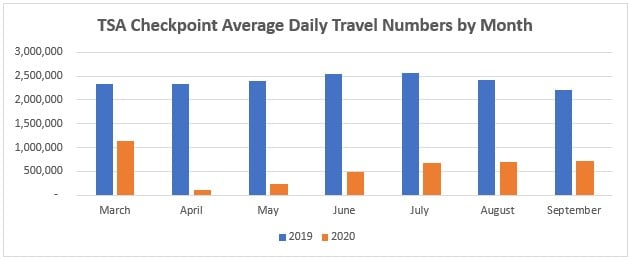Travelers have taken quite the hiatus during the COVID-19 pandemic. Especially when it comes to flying.
In 2019, millions of passengers would travel every day. In fact, the average number of daily airline travelers from March 1 – October 15, 2019 was just over 2.4 Million.
Those are the same six and a half months that the coronavirus has impacted the US. In 2020, this caused that daily average number to reduce significantly. From March 1 – October 15, 2020, the average number of daily flyers dropped to 595,396, according to TSA checkpoint travel numbers.
The initial fear of traveling makes sense. Why would you want to leave your home, where it’s safe, to get into a plane with filtered air and close contact to hundreds of strangers?
The good news is that the aircraft’s constantly filtered air is what makes a big difference when it comes to airflow and virus transmission.
The Independent Study
The Department of Defense worked with United Airlines to do 300 tests over the past six months. They tested dummies in-flight, and on the ground, to examine the possible spread of aerosol droplets.
The study replicated how a normal passenger would breathe and how particles contained in their breath move through an airplane. They also tested the difference if the mannequin wore a mask or if it didn’t.
A mannequin was placed on the aircraft and fitted with an aerosol generator to depict a passenger on an airplane. Technicians had the “infected” mannequin replicate breathing and coughing. There were sensors placed throughout the plane to test the spread of the aerosol droplets and see where and when they landed.
The researchers found that when the mask was worn by the mannequin, only 0.003% of aerosol particles made their way into other passengers’ breathing zones.
Why was the spread so small?
The study reflected similar studies that were done earlier this year that found that the unique airflow of airplanes can help minimize the risk of aerosol particles spreading.
On a plane, the airflow systems are designed to avoid the spread of disease with high air flow rates and air exchange rates, and highly effective filtration of any recycled air. The airflow also comes from above each seat, providing a continuous supply of filtered air. This process helps limit person-to-person airflow and particle spread.
Every two or three minutes, the air passes through a High Efficiency Particulate Air (HEPA) filter. A HEPA filter eliminates 99.99% of airborne particles.
According to the IATA, while the air flow and filtration is one of the most important processes to help reduce the spread of COVID-19 on an airplane, there are other aircraft characteristics that add additional layers of protection and reduce person-to-person transmission:
- Limited face-to-face interactions as passengers face forward and move about very little
- The effect of the seat-back acting as a physical barrier to air movement from one row to another
- The minimization of forward-aft flow of air, with a segmented flow design which is directed generally downward from ceiling to floor
- The high rate of fresh air coming into the cabin. Air is exchanged 20-30 times per hour on board most aircraft
- The use of HEPA filters which have more than 99.9% bacteria/virus removal efficiency rate ensuring that the air supply entering the cabin is not a pathway for introducing microbes
- The increase of aircraft cleaning and disinfection helps remove non-filtered particles between flights
Watch: Brain Corp and Tennant: Solving Today’s Airport Cleaning Challenges: How to Restore Traveler Confidence Through Best Practices & Robotics – Featuring Don Toole, Senior Vice President Sales and Marketing at Flagship.
How risky is COVID-19 to airline passengers?
The Department of Defense study shows that the risk of transmission is virtually non-existent when all passengers wear a mask properly.
The International Air Transport Association (IATA) stated “The risk of a passenger contracting COVID-19 while onboard appears very low… the vast majority of published cases occurred before the wearing of face coverings inflight became widespread”.
As additional support, one similar study was a joint publication by Airbus, Boeing and Embraer of separate computational fluid dynamics (CFD) research conducted by each manufacturer in their aircraft. While methodologies differed slightly, each detailed simulation confirmed that aircraft airflow systems do control the movement of particles in the cabin, limiting the spread of viruses.
Please note: The Department of Defense study has not been peer reviewed. While it shows that the risk of transmission extremely low when everyone wears a mask properly, that may occur less in real life. The study also did not test what happens if an infected person stands up or moves throughout the plane.
These are challenging times but Flagship's customizable approach to your airport, airline and aircraft needs will help you protect employees and travelers now and into the future.
Email an airport facilities expert today and get the help you need to keep traveler's healthy and safe.






Leave a Comment